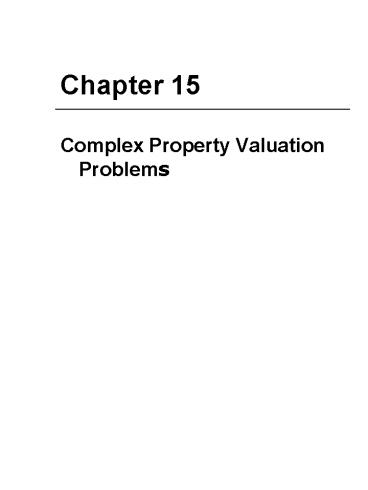Complex Property Valuation Problems
1 / 10
Title:
Complex Property Valuation Problems
Description:
Value declines as income earning potential drops ... Use past year-to-year rental rate changes to forecast ... Application of Gordon Growth Model. PV=R (r-g) ... – PowerPoint PPT presentation
Number of Views:22
Avg rating:3.0/5.0
Title: Complex Property Valuation Problems
1
Chapter 15
- Complex Property Valuation Problems
2
The Limitations of Traditional Appraisal
Techniques
- Value declines as income earning potential drops
- Value declines as capitalization rates rise with
property age and deteriorated market conditions - Need market forecast for first 10 years
- Estimates operating results and tells if cash
flows are enough to service loan - Estimates market value on year-by-year basis
indicating risk or principal loss if default
3
Figure 15.1
4
Figure 15.2
5
Developing a Multiple-Year Operating Forecast
- Forecasting gross revenue
- Changes in physical and locational
characteristics - Use past year-to-year rental rate changes to
forecast - Interaction of politics, economics and social
change - Forecasting operating expenses
- Use published data of actual results of groups of
buildings of different ages in same category to
estimate changes in subjects expenses - Forecasting changes in market value
- Value NOI/cap rate
- NOI projected
- Cap rates tend to revert to mean values
- As properties age, they typically fall into
different category/class with higher cap rates
6
Table 15.1
7
Table 15.2
8
Discounted Cash Flow Approach
- Cap ratediscount rate that expresses the PV of a
perpetual income stream if cash flow stream is
expected to last more than 40 to 50 years,
annuity factor is close to capitalization of the
first year cash flow at the same rate - Implicationsincome will change at a reasonable
constant rate - Application of Gordon Growth Model
- PVR (r-g)
- Where R is first year expected income r is
target rate of return, g is expected growth rate
of income - If significant shift in income, discount discrete
cash flows
9
Table 15.3
10
Table 15.4































